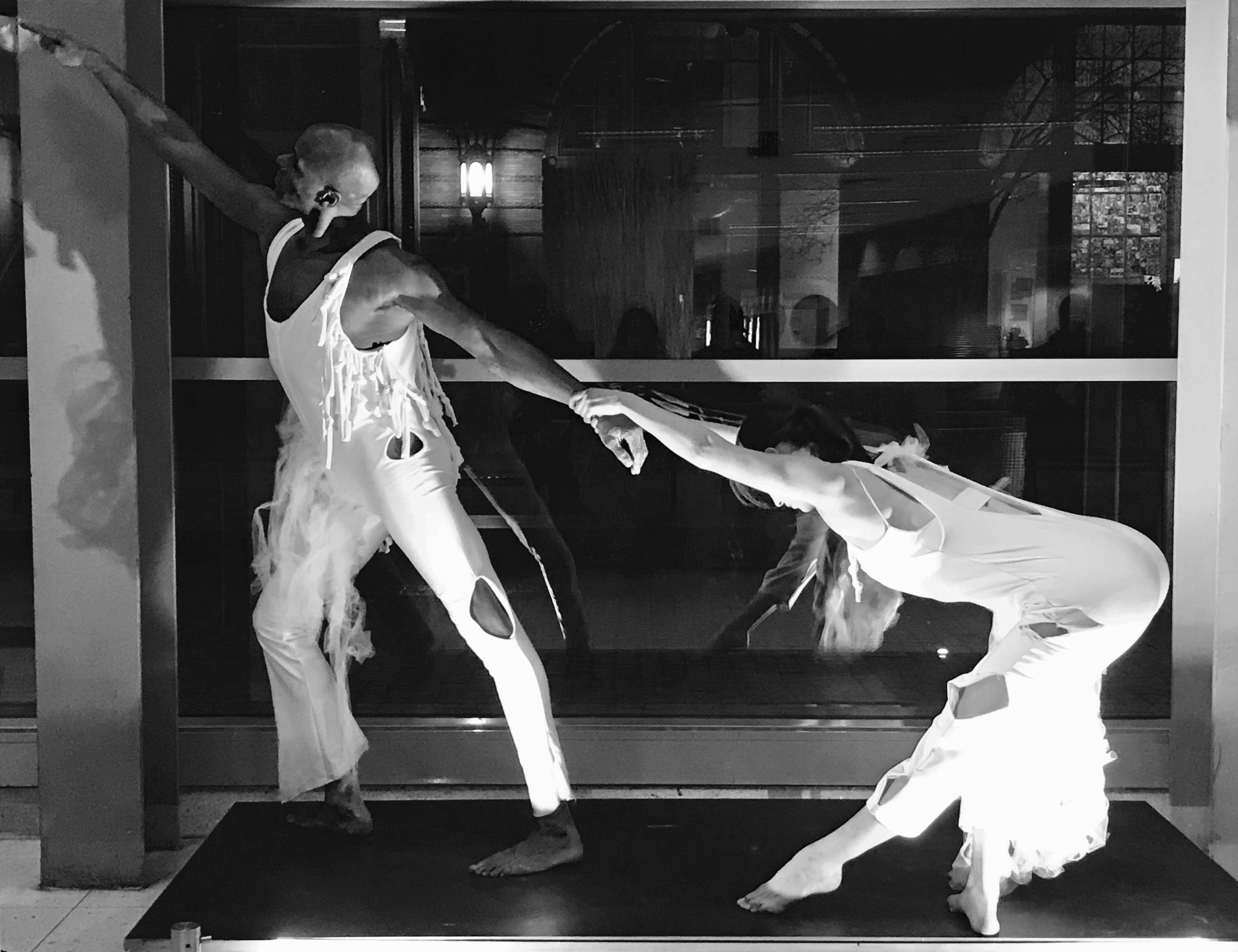Heidi Latsky’s D.I.S.P.L.A.Y.E.D. is reached through several stories of descending stairway (or elevator), balcony, and lobby. On each level are encountered living sculptures, sometimes still as stone and other times in stylized motion. They evoke both classical sculpture and avant-garde fashion, draped in white but wearing 3-D geometric adornments, wires and corners contrasting the flow and fall of the cloth. The primacy of idealized bodies is challenged by a man in (and out of) a wheelchair and other departures from normative aesthetics. Conventional notions of gender are bent by the costumes (contributed by seven or more artists and designers), the historical allusion of the poses emphasizing their cultural contingency.
As the Rose Nagelberg Theater of the Baruch Performing Arts Center is finally reached, the sculptural display continues into the space itself, the audience going amongst the still figures, able to stop and examine them in minute detail. Directly before entering the main space, the aerialist Erin Ball dances aloft in (and out of) her wheelchair. Some linger before taking a seat; others become part of the display. Lyrics play overhead: thirty texts that sound at first like the pre-autopsy recorded descriptions of corpses familiar from police procedurals. But it is apparent soon enough that they refer to living people with gaits, hats on their heads, mannerisms, and so on. The impulse to equate the descriptions with the performers is denied: an isolated feature may correspond here or there, but none add up to describe anyone before us. The clinical tone is, moreover, in contrast to the palpability of the dancers and their garments.
“Where ON DISPLAY is still, D.I.S.P.L.A.Y.E.D. explodes,” declares the show’s website, referring respectively to the exhibit and the dance. A familiar trope of sculpture is that it contains the potential of movement, particularly if it is of the human form. That is obviously true of this production, but so is its corollary, that the body in motion contains the potential of stillness. The shape of the dance, when it begins, is the explosion of stillness and its resettling, not through entropy but according to a sort of natural pulse of expansion and contraction.
Latsky is known for the use of physically diverse dancers, including those born with distinct characteristics or who acquire their “difference” as a result of life experience. The terms commonly used to describe this diversity seem out-of-place, except to the extent that we are made to jettison the assumptions they contain. In this, the going from stillness to motion and back in Latsky’s collaborative choreography is crucial. Movement elides physical differences; stillness, because it encourages the eye to play across the features of the body, sharpens it. Shifting from stillness to motion is a reminder that persons are not fixed in time but growing, evolving beings. D.I.S.P.L.A.Y.E.D. fights the tendency, particularly in matters of the body, to turn humans into things. But, although the moral danger is greatest when the person looked at is unmoving, the intent is not to demean stillness, only to reveal our inclinations toward it. In the ordinary course of a day, still bodies – in a photograph, say, or sunbathers at the beach – are routinely objectified. When the body in D.I.S.P.L.A.Y.E.D. explodes into movement, it changes how we saw it a moment before. Perhaps we looked at it clinically, turning a person into a thing, like the descriptions in the soundscape, or stereotypically, calculating, for no other reason than its outward characteristics, what it could or could not do. Now we see not it, but a living person, dance.
The dancers have astoundingly clear centers, no matter what their shape, and they shoot through space with lightning precision and a common energy. Propelled by a movement inducing and beautifully subtle soundtrack directed and arranged by Ximena Borges, the dancers acquire the pulse of a unified organism, yet one composed of unique beings – forty or more of them, if both the sculptures outside and the dancers onstage are counted. The achievement of D.I.S.P.L.A.Y.E.D. is not to suggest that difference can or should be ignored. It has the shape of lives as they are lived in all our bodies, or ought to be, organically and without prejudgment, mindfully, with ebb and flow.
The three-day run of D.I.S.P.L.A.Y.E.D. continues through March 10, 2018, at Baruch Performing Arts Center. For information, click here. Visit Heidi Lasky Dance for more on the company. Header image: dancers Desmond Cadogan and Victoria Dombroski, photo by Tatyana Kot.
